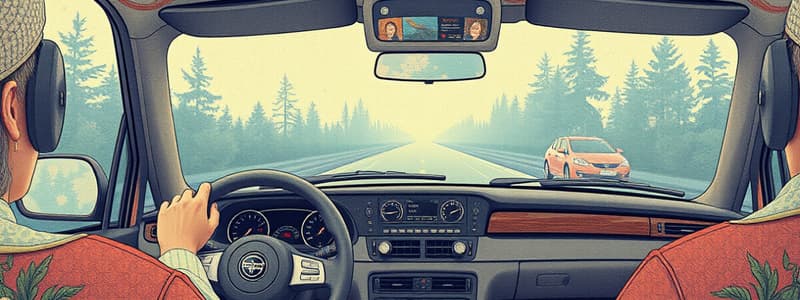Podcast
Questions and Answers
What does 'Aim High In Steering' help you do?
What does 'Aim High In Steering' help you do?
- Scan for pedestrians only
- Identify the distance to the next vehicle
- Ensure smooth stops and turns (correct)
- Center the car in traffic lane (correct)
What do you need to keep in mind when aiming high in steering?
What do you need to keep in mind when aiming high in steering?
Find a safe path well ahead.
What is the purpose of 'Get the Big Picture' habit?
What is the purpose of 'Get the Big Picture' habit?
- To improve vehicle speed
- To focus only on objects in front
- To understand the wider environment (correct)
- To drive without checking surroundings
How does 'Keep Your Eye's Moving' contribute to driving safety?
How does 'Keep Your Eye's Moving' contribute to driving safety?
Leave your self an ______
Leave your self an ______
Stale green lights are a safe indicator to proceed through an intersection.
Stale green lights are a safe indicator to proceed through an intersection.
What is the recommended following distance under 50 km/h?
What is the recommended following distance under 50 km/h?
When should you check your mirrors?
When should you check your mirrors?
Match the following driving strategies with their descriptions:
Match the following driving strategies with their descriptions:
What should you do when starting up at an intersection?
What should you do when starting up at an intersection?
Flashcards
Aim High in Steering
Aim High in Steering
Visualize a target ahead to maintain vehicle position and efficiently navigate turns.
Get the Big Picture
Get the Big Picture
Assess the entire surroundings (width and depth) to prevent hazards and smooth driving.
Keep Your Eyes Moving
Keep Your Eyes Moving
Scan the road systematically (front 2 sec, rear 5-8 sec) to increase awareness and prevent accidents.
Leave Yourself an Out
Leave Yourself an Out
Signup and view all the flashcards
Make Sure They See You
Make Sure They See You
Signup and view all the flashcards
Stopped in Traffic
Stopped in Traffic
Signup and view all the flashcards
Starting Up at Intersection
Starting Up at Intersection
Signup and view all the flashcards
Count ONE-TWO-THREE
Count ONE-TWO-THREE
Signup and view all the flashcards
Following Distance (Under 50 km/h)
Following Distance (Under 50 km/h)
Signup and view all the flashcards
Following Distance (Over 50 km/h)
Following Distance (Over 50 km/h)
Signup and view all the flashcards
Regular Mirror Checks
Regular Mirror Checks
Signup and view all the flashcards
Scan Steering Wheels
Scan Steering Wheels
Signup and view all the flashcards
Stale Green Light
Stale Green Light
Signup and view all the flashcards
Eye-Lead Time
Eye-Lead Time
Signup and view all the flashcards
Pulling from the Curb
Pulling from the Curb
Signup and view all the flashcards
Establishing Eye Contact
Establishing Eye Contact
Signup and view all the flashcards
Study Notes
UPS 5 Seeing Habits
-
Aim High In Steering
- Visualize an imaginary target to maintain vehicle position in traffic.
- Focus on a safe path well ahead to navigate turns efficiently.
-
Get the Big Picture
- Assess the width and depth of surroundings, including objects and ground.
- Staying aware prevents traffic hazards and promotes smooth stops and turns.
-
Keep Your Eyes Moving
- Maintain a scanning technique: check the front every 2 seconds; rear view every 5-8 seconds.
- Prevents accidents at intersections and ensures awareness of immediate surroundings.
-
Leave Yourself An Out
- Always have an escape route to ensure safety during unexpected events.
- Maintain space on all sides of the vehicle; be mindful of potential hazards.
-
Make Sure They See You
- Utilize horns, lights, and signals to communicate your presence in traffic.
- Aim for eye contact with other drivers to enhance safety.
Ten Point Commentary
-
Stopped in Traffic
- Maintain a one-vehicle-length gap between your vehicle and the one in front to prepare for potential issues.
-
Starting Up at Intersection
- Perform left-right mirror checks to ensure safe navigation before proceeding.
-
Count ONE-TWO-THREE
- After traffic signals change, wait a moment before moving to ensure the vehicle ahead has begun to move.
-
Following Distance
- Under 50 km/h: maintain a 4-6 seconds following distance.
- Over 50 km/h: increase following distance to 6-8 seconds; adjust based on road conditions.
-
Check Mirrors Regularly
- Every 5-8 seconds, check mirrors without allowing for mirroring to occur; cycle back from mirrors to forward view.
-
Scan Steering Wheels
- Look for telltale signs of vehicle activity to anticipate movements and ensure safety.
-
Stale Green Light Awareness
- Recognize a stale green light and determine whether to stop or proceed safely through the intersection.
-
Eye-Lead Time
- Maintain an 8-12 seconds eye-lead time, adjusting distance based on speed to improve situational awareness.
-
Pulling from the Curb
- Follow the THREE L's: signal left, check the left mirror, and glance over the shoulder for blind spots before departing.
-
Establishing Eye Contact
- Use signals and visual cues to ensure other drivers are aware of your vehicle’s presence, reducing risk of accidents.
Studying That Suits You
Use AI to generate personalized quizzes and flashcards to suit your learning preferences.




